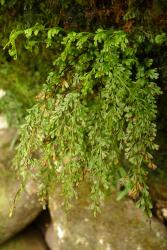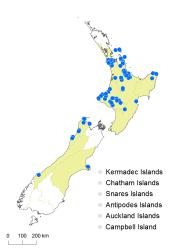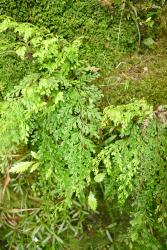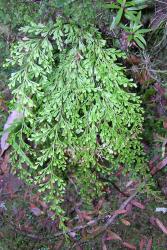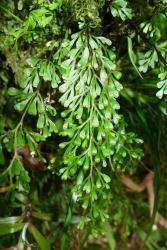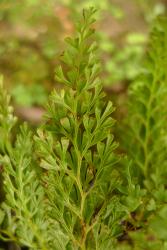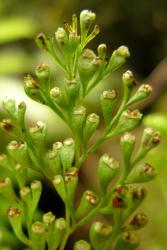- ≡ Odontosoria viridis (Colenso) Kuhn, Chaetopt., 26 (1882)
- ≡ Stenoloma viride (Colenso) C.Chr., Index Filic. Suppl. 3, 174 (1934)
- ≡ Sphenomeris viridis (Colenso) Brownlie, Trans. Roy. Soc. New Zealand 87: 197 (1959)
Rhizomes erect to short-creeping, up to 30 mm long (in herbarium specimens), 1.5–2 mm diameter, with stipes closely inserted; bearing scales. Rhizome scales narrowly ovate, 2–5 mm long, 0.2–0.5 mm wide, red-brown or golden brown. Fronds monomorphic, 40–400 mm long, laxly arching or pendent. Stipes 10–140 mm long, purple-brown or red-brown, glabrous. Rachises purple-brown or red-brown, becoming pale brown distally, narrowly winged distally, glabrous. Laminae 2-pinnate to 3‑pinnate-pinnatifid, narrowly elliptic or narrowly ovate, tapering to a pinnate apex, 30–300 mm long, 8–80 mm wide, bright green on both surfaces, herbaceous, glabrous. Primary pinnae in 7–20 pairs below terminal pinna, widely spaced especially proximally, arising at a narrow angle to the rachis and often overlapping, ovate or narrowly ovate; the longest below the middle, 5–90 mm long, 3–24 mm wide, apices acute or obtuse, bases short-stalked, divided into secondary pinnae. Secondary pinnae gradually decreasing in length along each primary pinna to the distal end; the longest secondary pinnae elliptic, 3–22 mm long, 1.5–11 mm wide, apices obtuse, bases stalked, sometimes divided into tertiary segments. Tertiary pinnae narrowly obovate, 4–7 mm long, 1–4 mm wide, apices truncate, bases stalked or adnate. Sori oblong or broader than long; indusia extending laterally 1–3 mm, more or less straight, free margin entire or slightly toothed.
Lindsaea viridis is recognised by its monomorphic fronds, purple-brown stipes and rachises, and narrowly elliptic to narrowly ovate laminae that are 2-pinnate to 3-pinnate-pinnatifid. The primary pinnae arise at a narrow angle to the rachis and often overlap. The ultimate segments are narrowly obovate and truncate. The indusia are oblong or slightly wider than long, and straight rather than curved.
North Island: Auckland, Volcanic Plateau, Gisborne, Taranaki, Southern North Island.
South Island: Western Nelson, Westland, Canterbury.
Altitudinal range: 0–850 m.
In the North Island, Lindsaea viridis occurs in lowland to montane areas from Great Barrier Island to the Bay of Plenty, East Cape, Waikato and Taranaki, but has not been recorded south of the central Ruahine Ranges. There is an isolated 19th century record from Petane, Hawke’s Bay (WELT P006895), but the species is otherwise absent from the east coast. It ranges from c. 30 m in Taranaki and at East Cape to 850 m on Mt Pirongia but is rare above 450 m. In the South Island it occurs in lowland sites of north-west Nelson as far south as Charleston, with outlying populations in the Cascade Valley near Jacksons Bay (CHR 311100; only approximately plotted on the map), and on Banks Peninsula. It ranges from near sea level to 100 m. There are early records that suggest it once had a wider distribution. There is a collection in the Armstrong Herbarium made in 1868 from Pigeon Bay (CHR 633526), but the species has not been recorded from Banks Peninsula since then (Wilson 2013). Also, Kramer & Tindale (1976) cite a collection made by Sinclair and Haast in 1860 from the "Province of Canterbury" (K, n.v.) and Cheeseman (1925) cites a Buchanan collection (n.v.) from the "Sounds of the West Coast". These localities cannot be precisely identified but are almost certainly outside the known distribution indicated on the map.
Lindsaea viridis is a terrestrial fern that grows in dark podocarp and broadleaved forest, on damp banks and rock faces, on rocks and boulders in streams, on river banks, beside waterfalls, and on road cuttings, often with mosses. It is an uncommon species, most frequently found above c. 100 m.
The species was given a conservation status of ‘Naturally Uncommon’ by de Lange et al. (2013).
n = c. 88 (Brownlie 1961).



